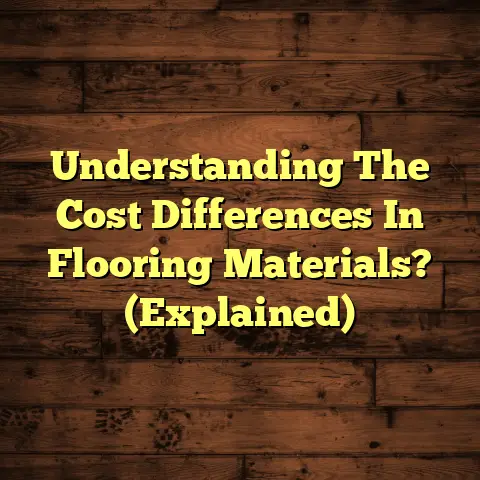HS Code For Mats & Carpet? (1 Dealer’s Edge!)
“When I was importing carpets for my store, the complexity of the HS codes felt overwhelming. But once I grasped their importance, it made all the difference in streamlining my imports.”
That’s a quote from a client of mine, Sarah, who runs a thriving rug business.
And it really hits home, doesn’t it?
Navigating the world of international trade can feel like wading through treacle, especially when you’re dealing with something as seemingly simple as mats and carpets.
But trust me, understanding HS codes can be a game-changer for your business.
Let’s dive in!
Section 1: What are HS Codes?
Okay, so what exactly are HS codes?
HS stands for Harmonized System.
Think of them as a universal language for products.
They are a standardized system of names and numbers to classify traded products.
The World Customs Organization (WCO) developed and maintains these codes.
And they’re used by more than 200 countries and economies.
That makes it the foundation for customs tariffs and trade statistics worldwide.
Basically, every single product that crosses an international border gets assigned an HS code.
This makes trade easier and more efficient.
Imagine trying to ship a container of Persian rugs without a standard classification system! Chaos, right?
HS codes bring order to that chaos.
They facilitate global trade by ensuring everyone’s on the same page regarding what’s being bought and sold.
Section 2: Importance of HS Codes for Mats and Carpets
Why should you, as a mats and carpets dealer, care about HS codes?
Simple: accurate classification directly impacts your bottom line.
The correct HS code determines the tariffs, duties, and regulations applied to your products.
Get it wrong, and you could face some serious consequences.
Think about it: a small error in classifying a shipment of coir mats could lead to:
- Increased tariffs: Paying more than you should.
- Customs delays: Holding up your shipment and frustrating customers.
- Fines and penalties: Ouch!
- Seizure of goods: Worst-case scenario!
Misclassification can also affect compliance with import/export regulations.
For example, some materials might be subject to specific restrictions or require special permits.
Using the wrong HS code could land you in hot water with customs authorities.
I’ve seen it happen.
A client of mine once misclassified a shipment of synthetic carpets.
They ended up paying a hefty fine and facing a lengthy investigation.
It was a costly mistake that could have been avoided with a little more due diligence.
Section 3: Breakdown of HS Codes for Mats and Carpets
Alright, let’s get down to the nitty-gritty.
What are the specific HS codes relevant to mats and carpets?
The main heading you’ll be looking at is Chapter 57 of the Harmonized System: Carpets and other textile floor coverings.
Within this chapter, you’ll find various subheadings that further classify different types of mats and carpets.
Here’s a simplified breakdown:
- 5701: Carpets of wool or fine animal hair, knotted.
- 5702: Carpets and other textile floor coverings, woven, not tufted or flocked, whether or not made up, including “Kelem”, “Schumacks”, “Karamanie” and similar hand-woven rugs.
- 5703: Carpets and other textile floor coverings, tufted, whether or not made up.
- 5704: Carpets and other textile floor coverings, of felt, not tufted or flocked, whether or not made up.
- 5705: Other carpets and other textile floor coverings, whether or not made up.
Let’s break that down further:
5701: Carpets of wool or fine animal hair, knotted.
This covers those beautiful, hand-knotted Persian or Oriental rugs.
The key here is the material (wool or fine animal hair) and the method of construction (knotted).
5702: Carpets and other textile floor coverings, woven, not tufted or flocked…
This includes woven rugs like kilims or dhurries.
They’re made on a loom, and they’re not tufted (meaning the pile isn’t inserted into a backing).
5703: Carpets and other textile floor coverings, tufted…
Tufted carpets are made by inserting loops of yarn into a backing material.
Most modern carpets fall into this category.
5704: Carpets and other textile floor coverings, of felt…
Felt carpets are made from compressed fibers.
You might find these in entryways or as industrial floor coverings.
5705: Other carpets and other textile floor coverings…
This is a catch-all category for anything that doesn’t fit neatly into the other headings.
It could include things like rubber mats, coir mats, or even some types of artificial turf.
Examples:
- A coir doormat would likely fall under 5705.
- A woven wool rug would be classified under 5702.
- A plush, synthetic carpet would be classified under 5703.
Criteria for Classification:
The HS system uses several criteria to classify mats and carpets, including:
- Material: What’s it made of? Wool, nylon, rubber, etc.
- Construction: How was it made? Woven, tufted, knotted, etc.
- Use: What’s it for? Doormat, bath mat, carpet, etc.
- Size and Shape: Is it a rug, a carpet, a mat?
It’s important to consider all these factors when determining the correct HS code.
Section 4: How to Determine the Correct HS Code for Your Products
Okay, so how do you actually find the right HS code for your mats and carpets?
Here’s a step-by-step guide:
-
Identify the Key Characteristics:
Start by carefully examining your product.
What is it made of? How was it constructed? What is its intended use?
The more information you have, the easier it will be to narrow down the possibilities.
-
Consult the Harmonized System Nomenclature:
The official HS nomenclature is the ultimate source of truth.
You can find it on the WCO website or through your local customs authority.
It’s a massive document, so you’ll need to use the index to find the relevant sections.
-
Use Online HS Code Search Tools:
Many websites offer free HS code search tools.
These tools allow you to search by keyword or product description.
While helpful, these tools shouldn’t be your only resource.
Always double-check the results against the official nomenclature.
Here are a few resources:
-
US Customs and Border Protection: https://www.cbp.gov/trade/rulings
-
The World Customs Organization: http://www.wcoomd.org/en/topics/nomenclature/overview/what-is-the-harmonized-system.aspx
-
-
Check with Your Customs Authority:
Your local customs authority is the best source of information for HS code classifications.
They can provide guidance and clarification on specific products.
Many customs authorities also offer online databases of past rulings, which can be helpful in determining the correct HS code.
-
Consult with a Customs Broker or Trade Specialist:
If you’re still unsure, consider hiring a customs broker or trade specialist.
These professionals have expertise in HS code classification and can help you navigate the complexities of international trade.
They can also help you avoid costly mistakes and ensure compliance with all relevant regulations.
Resources for Dealers:
- Customs Websites: Most countries have websites with information on HS codes and import/export regulations.
- Trade Associations: Industry-specific trade associations often provide resources and guidance on HS code classification.
- Industry Publications: Trade magazines and journals can offer insights into HS code trends and changes.
The Importance of Consulting with Experts:
I can’t stress this enough: when in doubt, ask for help.
HS code classification can be tricky, and it’s better to be safe than sorry.
A small investment in expert advice can save you a lot of money and headaches in the long run.
Section 5: Case Studies of HS Code Implications
Let’s look at some real-world examples of how HS code classification can impact businesses.
Case Study 1: The Misclassified Coir Mats
A small importer brought in a container of coir doormats from India.
They classified them under a general heading for “textile floor coverings.”
Customs flagged the shipment because coir mats have a specific HS code (usually within 5705).
The importer faced delays, fines, and had to re-label the entire shipment.
Lesson Learned: Specificity matters.
Always try to find the most precise HS code for your product.
Case Study 2: The Wool vs. Synthetic Rug Debate
A retailer imported rugs that were a blend of wool and synthetic fibers.
They initially classified them as “wool rugs” to take advantage of a lower tariff rate.
Customs inspected the shipment and determined that the synthetic content was significant enough to reclassify the rugs under a different heading with a higher tariff.
Lesson Learned: Be honest about the composition of your products.
Misrepresenting the materials can lead to serious penalties.
Case Study 3: The E-commerce HS Code Headache
An online retailer selling mats and carpets internationally struggled with HS code classification because they offered a wide variety of products.
They initially used generic HS codes for everything, leading to inconsistencies and delays.
They invested in a software solution that helped them automatically classify products based on their characteristics.
Lesson Learned: As your business grows, consider using technology to streamline HS code classification.
Section 6: The Future of HS Codes in the Flooring Industry
The flooring industry is constantly evolving.
New materials, manufacturing techniques, and trade agreements are emerging all the time.
These changes can impact HS code classifications.
Trends to Watch:
- Sustainable Materials: As eco-friendly flooring options become more popular, new HS codes may be needed to distinguish them from traditional products.
- Technological Advancements: Smart carpets and interactive floor coverings could require new classifications to reflect their unique features.
- E-commerce Growth: The rise of online sales is increasing the need for accurate HS code classification to ensure smooth cross-border transactions.
Potential Changes in Regulations:
Keep an eye on changes to trade agreements and regulations that could affect how mats and carpets are classified.
For example, new tariffs or trade restrictions could be implemented based on HS code classifications.
Impact of E-commerce and Globalization:
E-commerce and globalization are making it easier for businesses to buy and sell mats and carpets internationally.
But they also increase the complexity of HS code classification.
You need to be aware of the HS codes in different countries and ensure that your products are properly classified for each market.
Conclusion
Understanding HS codes is essential for any dealer in the mats and carpets market.
Accurate classification can save you money, avoid delays, and ensure compliance with regulations.
By taking the time to learn about HS codes and consult with experts, you can gain a competitive edge in your business.
Mastering HS codes isn’t just about avoiding problems.
It’s about optimizing your operations and maximizing your profits.
So, embrace the complexity, ask questions, and never stop learning.
Your bottom line will thank you for it!





